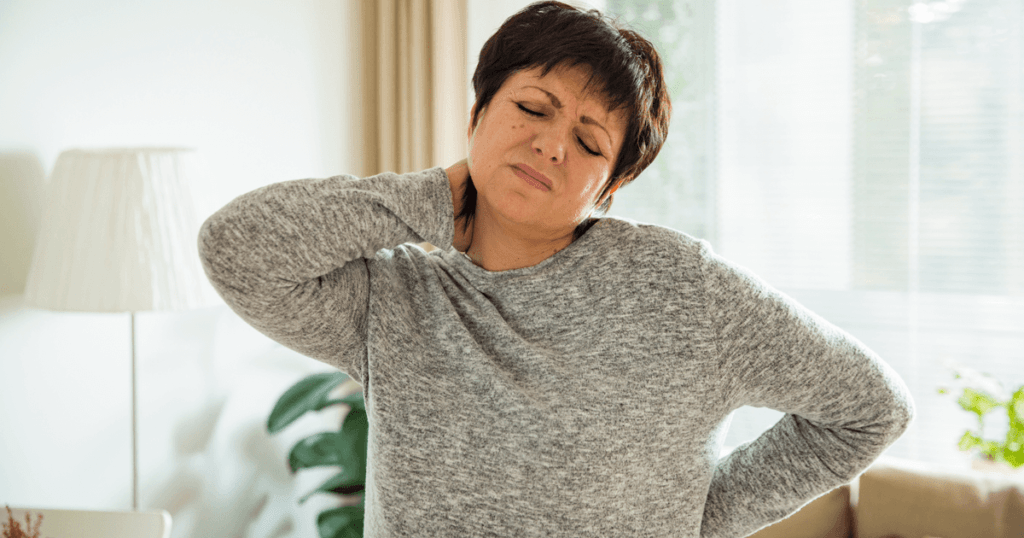Perimenopause, the transitional phase leading up to menopause, marks a significant juncture in a woman’s life. Alongside the well-known hormonal changes, perimenopause can bring about a range of unexpected physical symptoms, including shoulder pain. While shoulder pain might not be the most commonly discussed symptom during this phase, it can be distressing and disruptive. In this blog, we will delve into the relationship between shoulder pain and perimenopause, exploring the causes, symptoms, and management strategies.
Contents
- 1 Understanding Shoulder Pain
- 2 The Link Between Perimenopause and Shoulder Pain
- 3 Common Causes of Perimenopause and Shoulder Pain
- 4 Seeking Relief for Perimenopause and Shoulder Pain
- 5 Medical Treatments for Perimenopause and Shoulder Pain
- 6 Lifestyle Adjustments for Perimenopause and Shoulder Pain
- 7 Preventing Perimenopause and Shoulder Pain
- 8 Conclusion
Understanding Shoulder Pain

Shoulder pain is a common ailment that can range from a mild annoyance to a debilitating condition. The shoulder is a complex and mobile joint, allowing us to perform a wide range of movements. However, its intricate structure also makes it susceptible to various types of pain and injuries.
Anatomy of the Shoulder
The shoulder is a ball-and-socket joint composed of three main bones: the humerus (upper arm bone), scapula (shoulder blade), and clavicle (collarbone). Surrounding these bones are several important structures:
- Rotator Cuff Muscles and Tendons: A group of four muscles and their tendons that help stabilize and move the shoulder joint.
- Glenoid Cavity: The shallow socket on the scapula where the head of the humerus fits, forming the ball-and-socket joint.
- Labrum: A ring of cartilage that lines the glenoid cavity, providing stability and cushioning.
The Link Between Perimenopause and Shoulder Pain
Perimenopause is the transitional period that occurs before menopause, during which a woman’s body undergoes hormonal changes that eventually lead to the cessation of menstruation. This phase typically occurs in the late 30s to early 50s and is characterized by fluctuations in hormone levels, such as estrogen and progesterone.
Shoulder pain can have various causes, and while there is no direct link between perimenopause and shoulder pain, hormonal changes during perimenopause can potentially contribute to musculoskeletal discomfort and pain. Here’s how hormonal changes might play a role:
- Hormone Fluctuations: Estrogen and progesterone levels fluctuate significantly during perimenopause. Estrogen has a role in maintaining bone density and joint health, and its decline can lead to changes in the musculoskeletal system. This may result in conditions like osteoarthritis or other joint-related issues that could potentially cause shoulder pain.
- Muscle and Joint Changes: Hormonal changes can influence muscle tone and joint stability. Reduced estrogen levels might impact the elasticity and strength of ligaments and tendons, potentially leading to joint pain or instability in areas like the shoulder.
- Inflammation: Hormonal changes can also affect inflammation levels in the body. Increased inflammation could contribute to pain and discomfort in various parts of the body, including the shoulder.
Common Causes of Perimenopause and Shoulder Pain
Perimenopause is a phase characterized by hormonal fluctuations, and while there’s no direct causal relationship between perimenopause and shoulder pain, hormonal changes during this time can contribute to various factors that might lead to shoulder pain. Here are some common causes of perimenopause-related shoulder pain:
- Hormonal Changes: Estrogen and progesterone levels fluctuate during perimenopause. These hormonal changes can impact joint health, muscle tone, and overall musculoskeletal function. Reduced estrogen levels, in particular, can lead to changes in bone density and joint stability, potentially causing discomfort or pain in the shoulder and other joints.
- Osteoarthritis: The decline in estrogen levels during perimenopause can contribute to a higher risk of developing osteoarthritis, a condition characterized by the breakdown of cartilage in the joints. Shoulder joints can be affected by osteoarthritis, leading to pain, stiffness, and reduced range of motion.
- Tendon and Ligament Changes: Hormonal fluctuations can affect the elasticity and strength of tendons and ligaments. This can lead to joint instability and an increased risk of injuries, including in the shoulder.
- Muscle Tension: Hormonal changes and the stress associated with perimenopause can lead to muscle tension and spasms, potentially causing pain in the shoulder region.
- Sleep Disturbances: Sleep disturbances are common during perimenopause due to night sweats, hot flashes, and hormonal fluctuations. Poor sleep quality can contribute to muscle tension and pain, including in the shoulders.
Seeking Relief for Perimenopause and Shoulder Pain
If you’re experiencing perimenopause-related shoulder pain, there are several strategies you can consider to seek relief. It’s important to consult a healthcare professional to determine the underlying cause of your pain and to receive personalized recommendations. Here are some general approaches that might help alleviate perimenopause-related shoulder pain:
- Consult a Healthcare Professional: Start by seeing a healthcare provider, such as a primary care physician, gynecologist, or orthopedic specialist, to accurately diagnose the cause of your shoulder pain and receive appropriate treatment recommendations.
- Physical Therapy: A physical therapist can design a targeted exercise program to improve shoulder mobility, strength, and flexibility. Physical therapy can be effective in addressing musculoskeletal issues that may contribute to shoulder pain.
- Pain Management Techniques: Your healthcare provider might recommend pain management techniques such as heat or cold therapy, massage, or topical pain relief creams to alleviate discomfort.
- Medications: Depending on the severity of the pain, your healthcare provider may prescribe pain-relieving medications or anti-inflammatory drugs to manage shoulder pain. These should be used under medical supervision.
- Lifestyle Adjustments: Making healthy lifestyle changes can positively impact musculoskeletal health. Regular exercise, maintaining a healthy weight, and practicing good posture can help reduce the risk of shoulder pain.
Medical Treatments for Perimenopause and Shoulder Pain
Medical treatments for perimenopause-related shoulder pain depend on the underlying cause of the pain and the individual’s specific health circumstances. It’s important to consult a healthcare provider for proper diagnosis and to determine the most appropriate treatment approach. Here are some potential medical treatments that may be considered:
- Non-Steroidal Anti-Inflammatory Drugs (NSAIDs): NSAIDs like ibuprofen or naproxen can help reduce pain and inflammation associated with shoulder pain. They are available over-the-counter or in prescription strength, depending on the severity of the pain.
- Topical Analgesics: Topical creams, gels, or patches containing pain-relieving ingredients like capsaicin or lidocaine can provide localized relief for shoulder pain.
- Corticosteroid Injections: In cases of severe pain or inflammation, corticosteroid injections can be administered directly into the shoulder joint. These injections can provide temporary relief by reducing inflammation.
- Physical Therapy: A physical therapist can design a personalized exercise program to improve shoulder mobility, strength, and flexibility. They may also use techniques like manual therapy or ultrasound to address musculoskeletal issues.
- Hormone Replacement Therapy (HRT): If the shoulder pain is indirectly related to hormonal changes during perimenopause, hormone replacement therapy might be considered to manage perimenopause symptoms. However, the decision to use HRT should be made based on an individual’s overall health and needs.
Lifestyle Adjustments for Perimenopause and Shoulder Pain

Lifestyle adjustments can play a significant role in managing perimenopause-related shoulder pain. These changes can help improve overall musculoskeletal health, reduce pain, and enhance your quality of life. Here are some lifestyle adjustments to consider:
- Regular Exercise: Engage in regular, low-impact exercises that promote joint health and flexibility. Activities like walking, swimming, or gentle yoga can help improve circulation, maintain muscle tone, and reduce stiffness in the shoulders.
- Strength Training: Incorporate strength training exercises that target the muscles around your shoulders. Strengthening these muscles can provide better support to the shoulder joints and alleviate pain.
- Stretching and Flexibility: Perform gentle stretching exercises to maintain shoulder flexibility and prevent stiffness. Focus on stretches that target the chest, shoulders, and upper back.
- Posture Awareness: Practice good posture throughout the day. Avoid slouching and maintain a neutral spine alignment to reduce strain on the shoulders and upper back.
- Ergonomics: Ensure that your workstation, computer setup, and seating are ergonomically designed to support proper posture. This can help prevent shoulder pain caused by poor alignment.
- Weight Management: Maintain a healthy weight to reduce strain on your joints, including the shoulders. Excess weight can contribute to musculoskeletal discomfort.
Preventing Perimenopause and Shoulder Pain
Taking proactive measures to prevent shoulder pain is key to maintaining a pain-free life, especially during perimenopause.
Hormonal Balance
Consuming foods rich in omega-3 fatty acids, antioxidants, and vitamin D can help maintain hormonal balance, reducing the likelihood of inflammation-related shoulder pain.
Posture Awareness
Being mindful of your posture and making ergonomic adjustments at work and home can prevent unnecessary strain on the shoulder muscles.
Regular Exercise
Engaging in regular physical activity focused on shoulder strengthening and flexibility can enhance joint stability and reduce the risk of injuries.
Embracing Self-Care
Prioritizing self-care during perimenopause can contribute to overall well-being and alleviate shoulder pain.
Mind-Body Connection
Incorporating meditation, deep breathing, and relaxation techniques can ease muscle tension and promote a healthy mind-body connection.
Sleep Hygiene
Quality sleep is crucial for healing and maintaining optimal health. Proper sleep hygiene practices can enhance muscle recovery and reduce pain.
Conclusion
Navigating the challenges of perimenopause includes addressing unexpected symptoms like shoulder pain. By understanding the connection between hormonal changes and musculoskeletal health, and by adopting proactive lifestyle changes, women can embrace a life free from unnecessary shoulder pain.
Ultimately, each person’s experience with perimenopause and shoulder pain is unique, requiring personalized care and guidance. By working closely with healthcare professionals and making informed decisions, individuals can effectively address perimenopause-related shoulder pain and maintain a better quality of life.



